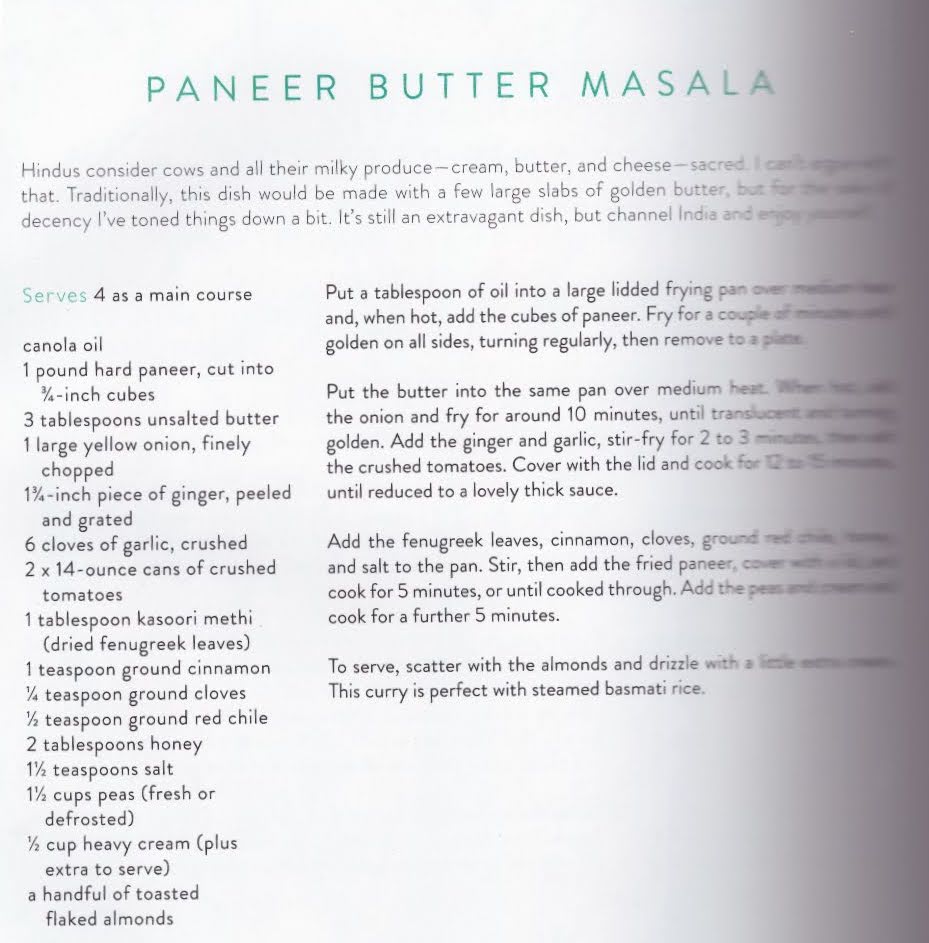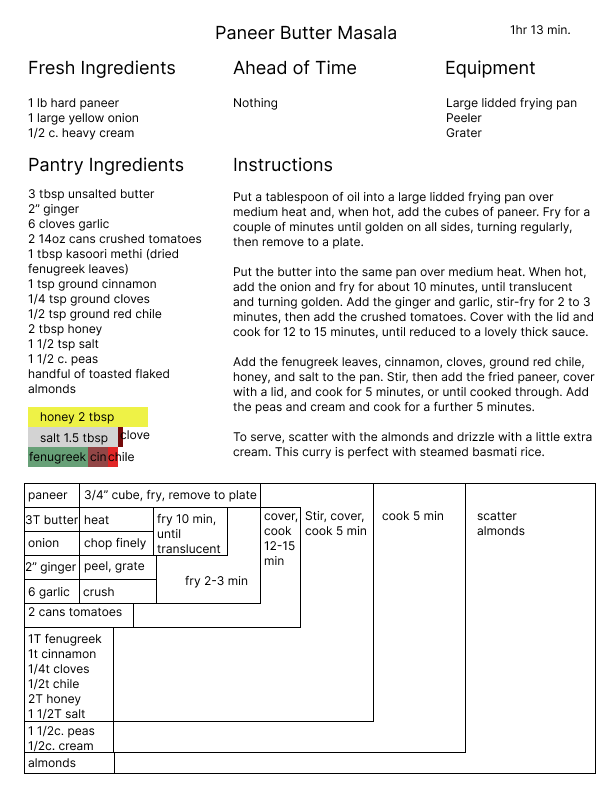This is post 1 of a few. The next is here.
Cooking is fun. But recipes are kind of limited. Here’s one:

(Chosen at random from the wonderful Fresh India by Meera Sodha; I don’t mean to pick on her, this book’s great! Also, forgive the scan.)
What’s limited about this? Nothing, if you know you want paneer butter masala, you have all the ingredients, your kitchen is perfectly outfitted, and time isn’t an issue. But that’s usually not the case; “cooking” is really just one part of a whole process here:
- Deciding what to cook
- Shopping
- Marinating (I’m including in this all “day-ahead” or “hours-ahead” tasks, including soaking beans, salting meat, etc)
- Prepping (Anything before you turn on the heat or otherwise become time-limited)
- Cooking
- Cleaning
Recipes address only a few bits of this. They target Cooking, sometimes Prepping and Marinating, and, if you don’t mind parsing a long list, Shopping. But a recipe could help you with this whole process! It just needs to be laid out better and include the right things.
What should a recipe include?
An ingredient list just for shopping
While you’re cooking, you want the list of ingredients in the order you use them. But when you’re scanning the recipe before going to the store, you want them in a different order: you want the “fresh things” separate from the “pantry things.” You’ll need to buy all the “fresh things”, but you’ll probably have the “pantry things” on hand, so you can quickly skim that part of it.
Also, separating the “fresh things” helps you think about each recipe. If you know that this only requires paneer, an onion, and cream, plus pantry ingredients, then you can make it whenever you happen to have those three things. (This is especially handy while expanding your horizons with vegetables; I’ve got a fennel salad recipe that I love, that I can make if I’ve got fennel, apples, a cucumber, and mint. So if I see fennel, I just then find those other three, and I’m good. Otherwise I’d never buy fennel because I wouldn’t know what to do with it.)
Some “planning but not shopping” things
- A “day ahead” section. You don’t want it to be a surprise that you have to marinate something overnight! Outline what someone will have to have done before rolling up their sleeves at 7pm to cook this.
- A list of equipment. You also don’t want this to be a surprise. If it needs an immersion blender at step 8, you should know this before you start. Also, this will help you know how much you’ll need to clean up.
- A realistic time estimate. All recipes underestimate, and I don’t know why. Maybe to sell you cookbooks, while you’re browsing? Anyway, this should be timed, by test cooks who are as unprofessional as the target audience, from the time they first open the fridge until they sit down for dinner. Timing will still vary from person to person, but let’s at least give it a better effort.
The instructions, in two forms
First, keep the traditional instructions. These are still worthwhile; most of those words are telling you something useful.
Second, include a “cooking for engineers” diagram of the recipe. This is a shorthand of the prose instructions. Here’s an example, from cookingforengineers.com:

All the ingredients start on the left; follow it over to the right, combining as you go. This is a quick reference, so it should be kept as simple as possible! If you need details, read the long-form instructions.
Also add any other graphics that would help. For one example, a scale diagram of the spice mix makes it more memorable to me. Make fancy graphics if they help embed make any concepts easier to learn or easier to memorize.
What you don’t need
- You don’t actually need a “serves 4” yield section. Look at the fresh ingredients; that’s about how much you’ll get out. This recipe makes about 1 lb of paneer. You decide how many people that serves.
- You don’t really need the fluffy story or the beautiful photos - but they don’t hurt! I think of these the same as the “instructions”: nice to read before you’re cooking. (And I know authors need them for SEO and copyright, alas.) While you’re cooking, though, get them out of the way.
One example

What’s good about this?
First, it addresses all six parts of the cooking process. Notably, it’s nicely segmentable: this top part is all you need for deciding “do I want Paneer butter masala, and what do I need to buy?”

And the bottom part, the “Cooking for engineers” diagram, is all you need while you’re cooking. Print it, cut it out, put it on a board in your kitchen, refer to it whenever you need. Emphasis on “print it” - don’t try to use an ipad or something, paper is 100% what you want for recipes while you cook. It doesn’t need to stay clean, you can mark it up, and you can tape it wherever it’s comfortable to consult it.
Second, this helps you learn the recipe. There’s usually 3 ways you can approach cooking a certain dish, based on your experience:
- reading the recipe thoroughly while trying to make it (not fun)
- mostly knowing what you’re doing, and consulting the recipe occasionally
- knowing it by heart, not even consulting a recipe (delightful)
This reformatted recipe will get you most of the way to Stage 2 the first time you make it. Getting to Stage 3 will take a few repetitions, but it will be a lot quicker than with a traditional recipe, because you don’t have to parse paragraphs each time.
This is a start
I don’t think this is The Answer. I’ve manually reformatted some of my recipes like this (with pen and paper) but I’m sure there’s still a long way to go.
But man, we need something here. Recipes as-is are optimized for ease of writing, not ease of use. And for all the work that goes into the thousands of cookbooks out there, if authors put 10% of that into a bit of redesigning the print layout, we’d have a masterpiece that redefines the genre and actually makes cooking more fun. I’d say I want this because I want to spread the gospel that cooking is great or something, but honestly I just want it for myself.
post script
I’m not the first person to try to rethink recipes. About once every 47 minutes, some software engineer somewhere says “Ah, recipes! Those look easy. A simple list of ingredients! I’ll make a software that will process those. You’ll tell it what food you have, and it will tell you what recipes you can make! Or, it will generate grocery lists for you!” Indeed, I went through an embarrassingly long phase of trying to computerize recipes myself. But these, and most computerizing-cooking ideas, are terrible. (if they don’t sound terrible, try them! the only thing worse is “the smart fridge that can text you when you’re out of milk.") If this post provides any value, it’s because I’ve spent 20 years cooking, not because of anything about computers.
blog 2025 2024 2023 2022 2021 2020 2019 2018 2017 2016 2015 2014 2013 2012 2011 2010